Power Improved
We dig deeper into the hardware behind the S550 performance specs
By Dale Amy
After months of anticipation, yesterday we finally got Ford’s official power figures for the 2015 Mustang lineup. As you now know, those numbers are:
• 5.0-liter V8: 435 hp & 400 lb-ft
• 3.7-liter V6: 300 hp & 280 lb-ft
• Ecoboost 2.3-liter I4: 310 hp & 320 lb-ft
But there’s more to the story than mere numbers, so let’s have a quick look at some of the S550’s powertrain hardware and changes.
Coyote 5.0

Aside from making it fit into the new platform, Ford’s seemingly impossible goals were to make the S550 GT’s V8 not only more powerful, but also cleaner, and even more fuel efficient than its predecessor.
Think of the result as something of a cross between the original Coyote and the Boss 302’s RoadRunner, with a bunch of new stuff thrown in. On the bottom end, the RoadRunner contributes its sinter-forged connecting rods—but not its forged pistons—to the S550’s Coyote. Instead, the pistons remain hypereutectic, with slightly revised valve clearance notches because of—you guessed it—slightly bigger valves. Compression remains at 11.0:1, while the forged-steel crank is rebalanced to accommodate these rod/piston changes.
The S550’s cylinder heads are all-new castings designed to recreate the RoadRunner’s deep breathing abilities without the need of that engine’s expensive CNC porting process. The intake ports are revised to take maximum advantage of both the larger valve package and the new engine’s lumpier camshafts. The exhaust cams are essentially RoadRunner bumpsticks, good for 13mm of lift. The all-new intake cams now also produce 13mm lift (even more than the 12mm of the Boss 302’s intake cams). Valve springs are stiffened accordingly.
Of course, the timing of those cams is variable, and Ford’s latest trick in that regard is a mid-lock timing phaser on the intake cams. Where previous setups traditionally had the intake cams fully retarded on start-up, the mid-lock strategy provides a more advanced start-up cam timing that improves cold-idle stability, economy, and emissions. The setup also provides more range of authority on intake cam timing, ultimately permitting better cruise fuel economy.
Up top is a new intake manifold. While quite similar in design, runner length, and height to the S197 Coyote intake, the new manifold bristles with Charge Motion Control Valves and their actuators. These valves introduce tumble and swirl into the airflow at part throttle, maximizing combustion efficiency.
Now don’t go having nightmares about the old Intake Manifold Runner Control system’s hindrance of intake airflow at wide-open throttle; the new ones are end-pivoting, not center-pivoting like the old IMRCs. Thus they fold completely flush into the wall of the runners at WOT, and there’s no shaft running through the center of the intake runners to mess with airflow. So we get better efficiency at cruise with no power penalty when gas pedal meets floorboard.
And that pretty much sums up the latest Coyote: Notably more grunt across the board and less fuel consumption. Meanwhile, the eco-geeks can sleep better at night knowing it’s also cleaner.
3.7 V6

According to Ford sources, changes to the base V6 are mostly limited to a revised upper intake due to the lower hoodline. Torque remains identical to the S197 version, but power drops by five ponies.
Still, at 300 hp, this smooth V6 remains a pretty healthy base engine, especially when you consider we used to be really excited when the GT had 225 horses on board.
Like the 2.3-liter EcoBoost I4, the V6 allows 52-percent front/48-percent rear weight distribution on the S550 platform (The GT’s split is 53/47.)
EcoBoost I4 2.3

We don’t have room here to get into all the guts and glory of this latest Mustang powerplant, but at 310 horsepower and 320 lb-ft of torque, we suspect it will find many takers. About the only commonality of this mill to any previous Duratec 2.3-liter variants are its bore centers and deck height. Starting with a new high-pressure die-cast aluminum block housing a steel crank, forged pistons and rods, and steel piston-ring carriers, the little EcoBoost also has an all-new head featuring an integrated exhaust manifold, twin variable cams, and direct injection.

A twin-scroll turbo is used, delivering high exhaust pulse energy to the impeller wheel in order to absolutely minimize low-rev turbo lag, and compression is a commendably high 9.5:1. Having ridden in some EcoBoost prototypes we can say that this is a surprisingly smooth and potent addition to the Mustang lineup.
Drivetrain Enhancements

Though the S550’s six-speed automatic and manual transmissions retain their respective 6R80 and MT82 nomenclature, both are improved for 2015. The most obvious bonuses with the latest 6R80 auto are its wheel-mounted paddle shifters, and downshift rev-matching, but revised calibration and hardware is said to make for improved shift response and a better user interface. There’s also an improved output shaft bearing.
The MT82 manual gets a redesigned, aluminum shifter linkage, as well as internal changes to reduce synchronizer drag and improve precision and gate-position feedback.

Moving to the back, the Mustang’s new IRS carries upgraded rear-axle hardware. Dimensional and metallurgical torque-density improvements are said to give these assemblies the strength of a 9.75-inch diff, while still retaining the 8.8-inch ring gear diameter. Ford apparently internally refers to this as the “Super 8.8.†The diff carrier itself is made of iron on manual-gearbox cars, and aluminum (to save a little weight) with automatics. Oh, and all 2015 Mustangs will come standard with limited-slip diffs; with a Torsen being part of the GT Performance Pack.
Check our photo captions for additional details on the S550’s powertrain components. And yes, all this tech talk sounds positive, but we can’t wait to get our butts firmly planted behind the steering wheels of this threesome of new Mustangs.

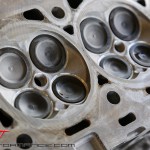
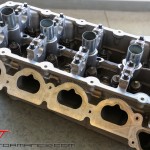
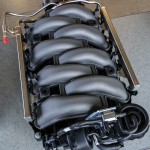
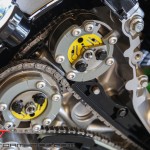
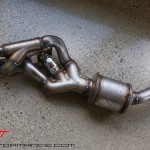
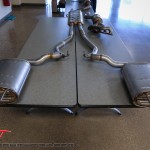
Whoa. I had wondered if the focus on the IRS center section might include any improvement in terms of added strength but I didn’t expect anything that would add much mass. It wasn’t as if pinion gears were failing behind the Trinity powered GT500. Sure sounds as if they have done this in preparation for some major shock loading. Good stuff!
Steve, I’m interested in the upcoming MT82 improvements. More specifically, the shifter. I take it the sloped support rods were added merely for display purposes as a measure to locate the aluminum block (also for display only) that resides where the rear bushing would normally be. Did Ford quote any relevant leverage ratio numbers in comparison to the S197 MT82 shifter? I’m just wondering if there was a “hands matching feet” change to either slow it down or speed it up as was done on the last GT500. And would you happen to have any other photos of the shifter you could post?
The support rods are for display purposes only.
There was no mention of the leverage ratio. We’ll have to get to that next time, so you better get that list of questions for me. 🙂
I’m working on it!
Other than price
How much ‘better’ Is the ecoboost 2.3 integrated exhaust ?